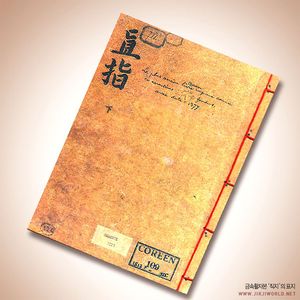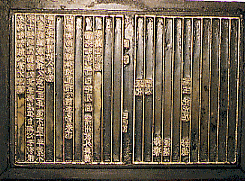جيكجي
| جيكجي | |
 الغلاف الأمامي للكتاب المطبوع بحروف طبع متحركة | |
| اسم كوري | |
|---|---|
| هانگول | 백운화상초록불조직지심체요절 |
| هانچا | 白雲和尙抄錄佛祖直指心體要節 |
| الرومنة المعدلة | Baegun hwasang chorok buljo jikji simche yojeol |
| مكيون-رايشاور | Paegun hwasang ch'orok pulcho chikchi simch'e yojŏl |
جيكجي (Jikji ؛ النطق الكوري: [tɕiktɕ͈i]) هو العنوان المختصر لوثيقة بوذية كورية، عنوانها يمكن ترجمته كالتالي "مقتطفات من تعاليم الزن لكبار الكهنة البوذيين".[1] لكونه قد طـُبـِع في عهد أسرة گوريو في 1377، فهو أقدم كتاب موجود في العالم مطبوع باستخدام حروف معدنية متحركة. وفي سبتمبر 2001، أكـَّدت اليونسكو أن جيكجي هو أقدم طبع معدني في العالم، وضمته إلى برنامج ذاكرة العالم.[2]
وقد نـُشـِر جيكجي في معبد هونگدوك في 1377، قبل 78 من قيام يوهانس گوتنبرگ بالطباعة الشهيرة "للكتاب المقدس ذي 42 سطر" في الأعوام 1452–1455.[3][4] الجزء الأكبر من جيكجي هو الآن مفقود، ولم يبق منه إلا المجلد الأخير منه، وهو محفوظ في قسم المخطوطات الشرقية في مكتبة فرنسا الوطنية.[4]
التأليف
The جيكجي was written by the Buddhist monk Baegun (1298–1374, Buddhist name Gyeonghan), who served as the chief priest of Anguk and Shingwang temples in Haeju, and was published in two volumes in Seongbulsan in 1372. Baegun died in Chwiam Temple in Yeoju in 1374.
المحتويات
The جيكجي comprises a collection of excerpts from the analects of the most revered Buddhist monks throughout successive generations. Gyeonghan compiled it as a guide for students of Buddhism, then Korea's national religion under أسرة گوريو (918–1392).
The text propounds on the essentials of Seon, the predecessor to Japan's Zen Buddhism.
The جيكجي consists of two volumes. The metal-print جيكجي that was published in Heungdeok Temple is kept in the Manuscrits Orientaux division of the National Library of France, with the first page of the last volume (Book 1 in Chapter 38) torn off. A wood-carving print of جيكجي published in Chwiamsa Temple contains the complete two volumes. This is kept in the National Library of Korea and Jangsagak and Bulgap temples as well as in the Academy of Korean Studies.
الطبع
On the last page of جيكجي is recorded details of its publication, indicating that it was published in the 3rd Year of King U (July 1377) by metal type at Heungdeok temple in Cheongju. The جيكجي originally consisted of two volumes totaling 307 chapters, but the first volume of the metal printed version is no longer extant.
There is a record indicating that in 1377 Baegun's students, priests Seoksan and Daldam, helped in the publication of جيكجي by using moveable metal type and the priestess Myodeok contributed her efforts as well.[2]
Jikji was made from movable type. Jikji and Johannes Gutenberg use different methods for printing.[5]
The surviving metal type's dimensions are 24.6 x 17.0 cm. Its paper is very slight and white. The whole text is doubly folded very slightly. The cover looks re-made. The title of جيكجي also seems to be written with an Indian ink after the original. The cover on the surviving volume of the metal type edition records in French "The oldest known Korean book printed with molded type, with 1377 as date", written by Maurice Courant.
The lines are not straight, but askew. The difference of the thickness of ink color shown on drawn letter paper is large, and spots often occur. Even some characters, such as 'day' (日) or 'one' (一), are written reversely, while other letters are not printed out completely. The same typed letters are not shown on the same paper, but the same typed letters appear on other leaves.[مطلوب توضيح] There are also blurs and spots around the characters.
مكتبة فرنسا الوطنية
[[Image:SelectedTeachingsofBuddhistSagesandSonMasters1377.jpg|thumb|Jikji, Selected Teachings of Buddhist Sages and Seon Masters, the earliest known book printed with movable metal type, 1377. [[مكتبة فرنسا الوطنية]، پاريس.]]
Towards the end of the Joseon Dynasty, a French diplomat bought the second volume of the جيكجي in Seoul and took it off to France, where it is now kept at the National Library of France in Paris.
According to UNESCO records, the جيكجي “had been in the collection of Victor Emile Marie Joseph Collin de Plancy, a chargé d'affaires with the French Embassy in Seoul in 1887 during the reign of King Gojong. The book then passed into the hands of Henri Véver, a collector of classics, in an auction at Hotel Drouot in 1911, and when he died in 1950, it was donated to the Bibliothèque Nationale de France, where it has been ever since.” Today only 38 sheets of the second volume of the metal print edition are extant.
In May 1886, Korea and France concluded a treaty of defense and commerce, and as a result in 1887 official diplomatic relations were entered into by the treaty's official ratification by Kim Yunsik (1835–1922) and Victor Emile Marie Joseph Collin de Plancy (1853–1924). Plancy, who had majored in law in France and went on to study Chinese, had served for six years as translator at the French Legation in China, between 1877 and 1883. In 1888 he went to Seoul as the first French consul to Korea, staying until 1891. During his extended residence in Korea, first as consul and then again as full diplomatic minister from 1896–1906, Victor Collin de Plancy collected Korean ceramics and old books. He let Kulang, who had moved to Seoul as his official secretary, classify them.
Although the channels through which Plancy collected his works are not clearly known, he seems to have collected them primarily from the early 1900s. Most of the old books Plancy collected in Korea went to the National Library of France at an auction in 1911, while the metal-printed جيكجي was purchased in that same year for 180 francs by Henri Véver (1854–1943), a well-known jewel merchant and old book collector, who in turn donated it to the French National Library in his will.[6]
اعادة الاكتشاف
أصبح جيكجي المطبوع معدنياً معروفاً للعالم في 1901 بعد ضمه إلى ملحق هانگوك سوجي، الذي جمّعه عالم الصينيات الفرنسي ودارس كوريا، موريس كوران (1865–1935). وفي 1972، عـُرِض جيكجي في پاريس أثناء "السنة الدولية للكتاب" التي استضافتها مكتبة فرنسا الوطنية، مما أسبغ على الكتاب اهتماماً عالمياً لأول مرة. The book was "rediscovered" by Dr. Park Byung Sun who was working as a librarian in the National Library of France. Dr. Park died in 2011.
طـُبـِع جيكجي was printed using metal print in Heungdeok Temple outside Cheongjumok في يوليو 1377، a fact recorded in its postscript. حقيقة أن الكتاب طـُبـِع في معبد هونگدوك في Uncheondong، تشئونگجو، تأكدت حين قامت جامعة تشئونگجو بحفريات في موقع معبد هونگدوك في 1985.
Heungdeok Temple was rebuilt in March 1992. In 1992, the Early Printing Museum of Cheongju was opened, and it took the جيكجي as its central theme from 2000.
Only the final volume of the جيكجي is preserved by the Manuscrits Orientaux department of the National Library of France.
On September 4, 2001, the جيكجي was formally added to UNESCO's Memory of the World. The Jikji Memory of the World Prize was created in 2004 to commemorate the creation of the جيكجي.
جدل
The right of ownership remains disputed, with the French National Library maintaining that the جيكجي should remain in France, while Korean activists argue it should belong to Korea.[7] The National Library of France says that as an important historical artifact of all mankind, the جيكجي should remain in France as it represents a common, worldwide heritage, and does not belong to any one country. In addition, they claim the جيكجي would be better preserved and displayed in France because of the prestige and resources the Library possesses. On the other hand, Korean organizations claim that it should belong to its country of origin and that it carries historical significance for the Korean people. The Committee to Bring Jikji Back to Korea led by the American Richard Pennington[8] is one such organization in Seoul, Korea that is working to repatriate the Jikji back to Korea from France. وقد وعد الرئيس الفرنسي فرانسوا ميتران بالتحقيق في سبل إعادة مختلف الكتب الكورية، بما فيهم جيكجي, should the French high-speed rail technology be exported to Korea.[7] From April to June 2011, 297 volumes with 191 different Uigwes of the Kyujanggak (Oegyujanggak), were shipped back in four separate installments and subsequently kept at the National Museum of Korea.[9] However جيكجي was not included, following opposition in France, including a protest lodged by the librarians of the National Library.[10]
انظر أيضاً
- حرف طبع متحرك
- History of typography in East Asia
- البوذية الكورية
- National Library of France
- Gutenberg Bible
- تاريخ كوريا
- جائزة جيكجي
- Diamond Sutra - earliest dated example of block printing
المراجع
- ^ Baegun hwasang chorok buljo jikji simche yojeol (vol.II), the second volume of "Anthology of Great Buddhist Priests' Seon Teachings", unesco.org, accessed June 2011
- ^ أ ب Memory of the World, unesco.org, accessed November 2009
- ^ Jordan (editor), Nicole (2012). Michelin Green Guide South Korea. Michelin Guide. p. 387. ISBN 978-1907099694.
{{cite book}}:|last=has generic name (help) - ^ أ ب "Jikji: An Invaluable Text of Buddhism". The Korea Times. April 1, 2010. Retrieved February 9, 2017.
- ^ "직지심체요절". terms.naver.com (in الكورية). Retrieved 2019-10-16.
- ^ "The Earliest Surviving Book Printed from Movable Metal Type (1377) : HistoryofInformation.com". www.historyofinformation.com (in الإنجليزية). Retrieved 2017-10-16.
- ^ أ ب cceia.org Archived 2010-08-21 at the Wayback Machine
- ^ http://richardpennington.com/index.php/publications/entry/the-jikji-prize-award-ceremony-in-cheongjuseptember-12-2013
- ^ Lee, Claire "Ancient Korean royal books welcomed back home" Korea Herald. 6 December 2011. Retrieved 2012-04-23
- ^ Lee, Kyong-hee. "Joseon Royal Books Return Home after 145 Years in France." The JoongAng Ilbo. koreana.or.kr
وصلات خارجية
- CS1 errors: generic name
- CS1 الكورية-language sources (ko)
- Articles containing كورية-language text
- جميع الصفحات التي تحتاج تنظيف
- مقالات بالمعرفة تحتاج توضيح from September 2014
- گوريو
- نصوص بوذية كورية
- العلوم والتكنولوجيا في كوريا
- نصوص المهايانا
- مجموعات مكتبة فرنسا الوطنية
- سجل ذاكرة العالم
- كتب عقد 1370
- تفاسير بوذية
